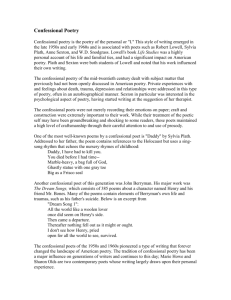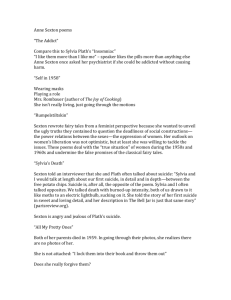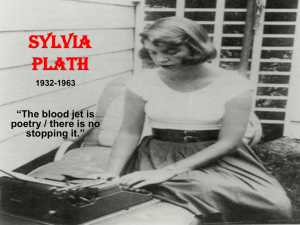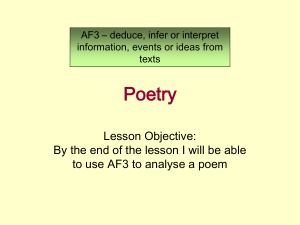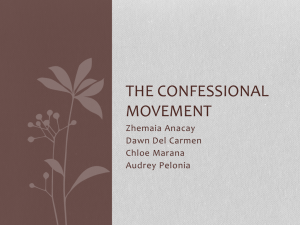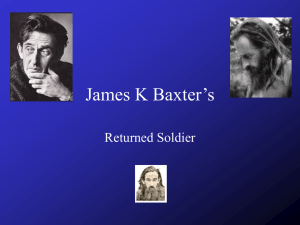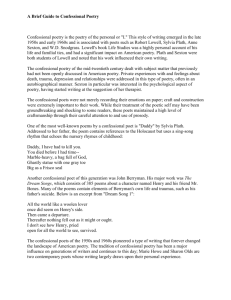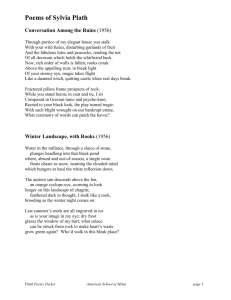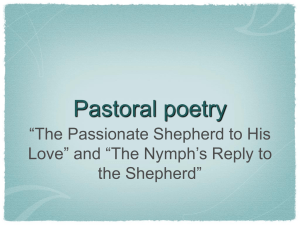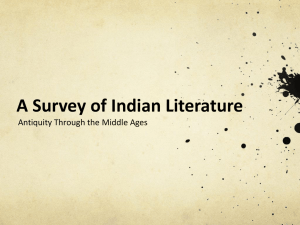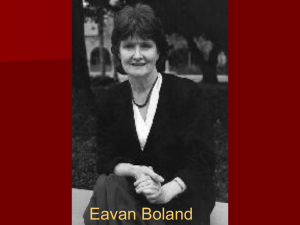Confessional Poetry - MHS AP Literature 2013
advertisement
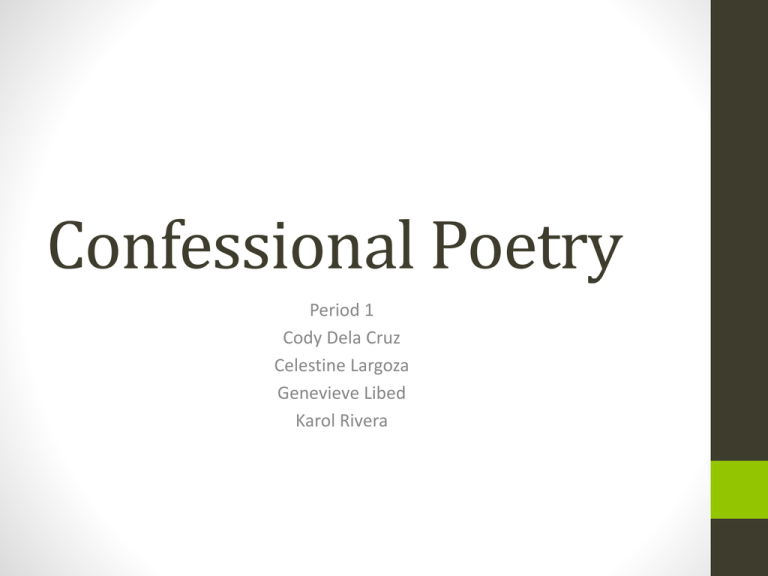
Confessional Poetry Period 1 Cody Dela Cruz Celestine Largoza Genevieve Libed Karol Rivera Background Information • Emerged in the 1950s and 60s , during the US Civil Rights movement and women subordination (50s) and women liberation (60s). • Written almost like an autobiography. • Depression, suicidal tendencies, alcoholism, drug abuse, and sexual affairs are usually the topics. • “Poetry of the personal or ‘I’ “ • Writer usually refers to real events. • Each poet utilizes rhyme, rhythm, meter, tone, and prosody. Sylvia Plath • Plath was born on October 27, 1932 in Boston, Massachusetts. • Her mother, Aurella Schober, a student at Boston University married her professor, Otto Plath. • At the age of eight years old her father died from diabetes and due to his strict attitude and their relationship, he plays a big role on her poetry. • In 1953 Sylvia Plath attempted a suicide, but was still able to graduate in 1955. • 1956 she married Ted Hughes and in 1960 she gave birth to Frieda Hughes and in 1962 to Nicholas Hughes. • After Nicholas Hughes birth Ted left her for Assia Gutmann Wevill. • That winter Plath wrote her most famous book, “Ariel.” • In 1963 wrote a note to her neighbor telling him to call a doctor then committed suicide. Notable Works • • • • • The Colossus (1960) Ariel (1965) Crossing the Water (1971) Winter Trees (1972) The Collected Poems (1981) Analysis: Family Reunion (1950) • Theme: Having to hide who she really is in fear of not being accepted by her family. • This also relates to society because there are times when people feel like they must mask who they really are so they can fit in with the social norms • Alliteration: In the poem Plath rhymes the ending words • (Hear, near) (Talk, walk) (Claws, pause) (Heat, beat) (Thin, within) (Meeting, greeting) (Breath, Elizabeth) (All, Uncle Paul) (Whine, line) (Land, stand) • Similes: • “Like a diver on a lofty spar of land Atop the flight of stairs I stand.” • “And hands like nervous butterflies; While rough as splintered wood” Robert Lowell • Born on March 1, 1917 in Boston, MA • He was violent and bullied kids his age • He attended Harvard College for two years before transferring to Kenyon College, received an undergraduate degree in 1940. • He took graduate courses at Louisiana State University • He wrote formal poetry containing meter and rhymes. • He was against WWII, and was imprisoned. • Had manic depression • Died after a heart attack in 1977. Notable Works • Lord Weary's Castle (1946) • 1947 Pulitzer Prize • Life Studies (1959) • Mixed of free and metered verse • Imitations (1961) • For the Union Dead (1964) • The Dolphin (1973) • 1974 Pulitzer Prize • History (1973) • Day by Day (1977) • Free Verse Analysis: To Speak of Woe That Is in Marriage (1976) • • • • Tone: Sad, regretful, and worried Shift in tone Simile: “he stalls above me like an elephant” Uses Rhyming Couplets • • • • • Disputes, Prostitutes Edge, Pledge Lust, Unjust Five,Alive Tie,Thigh • Theme: Marital Breakdown • Some marriages are not as perfect as they seem. • Some people find sadness in marriage, leading to loss of interest but still have a strong feeling for lust. John Berryman • Born October 25, 1914 in McAlester, Oklahoma • Considered a key figure in the Confessional school of poetry • He was scarred by his fathers suicide & wrote about his struggle with it in his Dream Songs • Berryman went to college at Columbia College where he studied with literary scholar Mark Van Doren • Credited Van Doren for sparking his interest in writing poetry seriously • Died January 7, 1972 in Minneapolis, Minnesota Notable Works • Best-known work is The Dream Songs Analysis: Dream Song 14 (1969) • Theme: Despite all the luxuries we have, life will always have no meaning. • Literary Devices: Irony Simile • Tone: Dissatisfied Anne Sexton • Born Anne Gray Harvey in Newton, MA on November 9, 1928 • Modeled for Boston's Hart Agency for a short time • Suffered from bipolar disorder, in 1955 she met Dr. Martin Orne who encouraged her to take up poetry – her form of therapy • Morning of October 4, 1974, Sexton had lunch with poet Maxine Kumin revise last book. On returning she locked herself in her garage, and started the engine of her car, committing suicide by carbon monoxide poisoning. Notable Works • Standard themes of depression, isolation, suicide, and despair, also issues specific to women, such as menstruation and abortion, masturbation, and adultery. • Actually books of poems • The Awful Rowing Toward God • The Death Notebooks • To Bedlam and Part Way Back • All My Pretty Ones • Live or Die – Pulitzer prize winning Analysis: Wanting to Die • Figurative language: • Personification • Shift in tone in 9th stanza • Simile • Metaphor • Theme: Curiosity , Curiosity will not cause us to die Maman Louise Bourgeois Precious Liquids Louise Bourgeois cylindrical bedroom with installed vials filled with blood, sperm, and tears. Quiz Name 3 of the topics that Confessional poetry is based on. Answer Depression, suicidal tendencies, alcoholism, drug abuse, sexual affairs Question #2 Who played a big role on Sylvia Plath’s poetry? Answer Her father Question#3 Why was Robert Lowell imprisoned? Answer He was against WWII Question #4 What event influenced John Berryman’s Dream Songs? Answer His father’s suicide Question#5 Dr. Martin Orne encouraged Anne Sexton to take up poetry as a form of therapy for what? Answer Bipolar disorder Question#6 Who is this poet? Answer Anne Sexton Question#7 When did Confessional Poetry emerge? Answer 1950’s and 60’s during the U.S. Civil Rights Movement Question#8 What 2 poetry movements formed as a reaction to Confessional poetry? Answer Language and New Formalist poetry Question#9 How did the movement get it’s name? Answer M. L. Rosenthal used “confessional” in a review on Robert Lowell’s Life Studies Life Studies is underlined AP Prompts • Based on the poem given, analyze the literary techniques, theme, and focus and explain how it is apart of the Confessional Movement. (see next slide) • Write an essay in which you compare and contrast the themes and techniques used in Family Reunion and Dream Song 14. Cinderella by Sylvia Plath The prince leans to the girl in scarlet heels, Her green eyes slant, hair flaring in a fan Of silver as the rondo slows; now reels Begin on tilted violins to span The whole revolving tall glass palace hall Where guests slide gliding into light like wine; Rose candles flicker on the lilac wall Reflecting in a million flagons' shine, And glided couples all in whirling trance Follow holiday revel begun long since, Until near twelve the strange girl all at once Guilt-stricken halts, pales, clings to the prince As amid the hectic music and cocktail talk She hears the caustic ticking of the clock. Bibliography • http://copof10.umwblogs.org/multimedia-rptlist/confessional-poetry/ • http://www.poets.org/viewmedia.php/prmMID/5650 • http://www.poets.org/poet.php/prmPID/11 • http://www.poets.org/poet.php/prmPID/10 • http://en.wikipedia.org/wiki/Anne_Sexton • http://www.poetryfoundation.org/bio/anne-sexton • http://en.wikipedia.org/wiki/John_Berryman Helpful Links • http://www.poets.org/poet.php/prmPID/6 • http://www.poemhunter.com/ • http://www.poetryfoundation.org/
